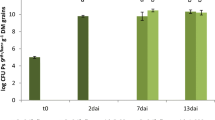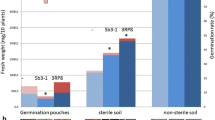Summary
Fusarium oxysporum f. sp.dianthi, pathogenic on carnation plants is very sensitive toBacillus subtilis M51 inhibition.Fusarium oxysporum disease (fusariosis) is prevented for a period of two months after treatment of plants withBacillus subtilis M51. The persistence ofB. subtilis M51, marked for selenomycin resistance (MZ51) and inoculated on the roots of carnation cuttings was studied. Soil used was two types: naturally infested withFusarium oxysporum and free from this pathogen. Bacterial cells presence on the roots was detected by direct plating and the presence of the pathogen in the roots was investigated by histological assays. Evidence gathered by these procedures suggest that plant protection is dependent on the physical presence ofB. subtilis M51 cells on the roots.
Similar content being viewed by others
References
Aldrich J and Baker R 1970 Biological control ofFusarium roseum f. sp.dianthi byBacillus subtilis. Plant Dis. Rep. 54, 446–448.
Bagnoli G, Filippi C and Picci G 1985 Applicazioni e limiti della batterizzazione di materiale di propagazione vegetale nell'ambito della lotta biologica. XXI Congr. Naz. Microbiol. Roma.
Baker K F and Cook R J 1982 Biological control of plant pathogens Ed Garret S D Amer. Phytopath. Soc., St Paul, Minnesota.
Bowen G D and Rovira A D 1966 Microbial factor in short term phosphate uptake studies with plants. Nature 211, 665–6.
Broadbent P, Baker F and Waterworth J 1971 Bacterial and actinomycetes antagonistic to fungal root pathogens in Australian soils. Aust. J. Biol. Sci. 24, 925–944.
Broadbent P, Baker K F and Johnston N 1974 Effect ofBacillus spp. on growth of seedlings in steamed soil. Aust. J. Agric. Res.
Brown M E, Burlingham S K and Jackoson R M 1962 Studies onAzotobacter species in soil. II. Population of Azotobacter in the rhizosphere and effects of artificial inoculation plant soil. Plant and Soil 17, 320–332.
Chang J P and Kommedahl T 1968 Biological control of seedling blight of corn by coating kernels with antagonistic microorganisms. Phytopathol. 58, 1395–1401.
Dimock A W 1948 Suggestion for the control of carnation diseases. Carnation craft I, 4, 5–6.
Elad Y, Chet I and Henis Y 1982 Degradation of plant fungi byTrichoderma harzianum. Can. J. Microbiol. 28, 719–725.
Filippi C, Bagnoli G and Picci G 1983 Effetto antimicotico ad ampio spettro di un batterio del terreno nei riguardi di specie fitopatogene, opportunistiche e saprofite. XX Congr. Naz. Microbiol. Brescia, Gardone Riviera.
Filippi C, Bagnoli G, Treggi G and Picci G 1984 Antagonistic effect of soil bacteria onFusarium oxysporum f. sp.dianthi (Prill and Dell.) Snyd. and Hans. IIn vitro experimental and preliminary assays on carnation (Dianthus caryophyllus L.). Plant and Soil 80, 119–125.
Filippi C, Bagnoli G and Picci G 1985 Effetto antagonista di batteri terricoli suFusarium oxysporum Schlecht f. sp.dianthi (Prill and Del.) Snyd. and Hans. II Effetto antimicotico ad ampio spettro di un batterio del terreno nei riguardi di specie fitopatogene, opportunistiche e saprofite. L'Agr. It. 1/2. 27–40.
Jenny H and Grossembacher K 1963 Root-soil boundary zones as seen in the electron microscope. Proc. Soil Sci. Soc. Am. 27, 273–277.
Kirby W M N, Sherris J C and Tuzch M 1966 Antibiotic susceptibility testing by a standardized single-disc method. Am. J. Clin. Pathol. 45, 439–496.
Lepidi A A, Filippi C, Casella S and Nuti M P 1980 Controllo biologico diFusarium oxysporum Linkin vitro ed in campo su pomodoro, melone e cipolla.
Mankau R 1980 Biological control of nematode pests by natural enemies. Annu. Rev. Phytopathol. 18, 415–440.
Merriman P R, Price R D, Piggot T and Ridge E H 1974 Effect of seed inoculation withBacillus subtilis andStreptomyces griseus on the growth of cereals and carrots. Aust. J. Agric. 25, 219–226.
Mishutin E N and Naumova A N 1962 Bacterial fertilizers, their effectiveness and mode of action. Mikrobiologiya 31, 543–555.
Nair N G and Fahy P C 1972 Bacterial antagonistic toPseudomonas tolaasii and their control of brown blotch of the cultivated mushroomAgaricus bisporus. J. Appl. Bacteriol. 35, 439–442.
Patel J J and Brown M E 1969 Interaction of Azotobacter with rhizosphere root-surface microflora. Plant and Soil 31, 273–281.
Phillips J M and Hayman D S 1970 Improved procedures for clearing roots and staining parasitic and vesicular-arbuscolar mycorrhizal fungi for rapid assessment of infection. Transaction British Mycol. Soc. 55, 158–160.
Ridye E H and Rovira A D 1968 Microbial inoculation of wheat. Trans. Int. Congr. Soil Sci. qth, III, 473–481.
Rovira A D 1965 The effect ofAzotobacter, Bacillus andClostridium on the growth of wheat.In Plant Microbe Relations. Eds. J. Macura and V. Vancura pp 193–200, Czech. Acad. Sci., Prague.
Rovira A D and Bowen G D 1969 Phosphate incorporation by sterile and non-sterile roots. Aust. J. Biol. Sci. 19, 1167–1169.
Tweit M and Wood R K S 1955 The control of Fusarium blight in oat seedlings with antagonistic species of Chaetomium. Ann Appl. Biol., 43, 538–552.
Vrany J, Vancura V and Stanek M 1981 Control of microoganisms in the rhizosphere of wheat by inoculation of seed withPseudomonas putida and by foliar application of urea. Folia Microbiol. 26, 45–51.
Wood R K S and Tweit M 1955 Control of plant disease by use of antagonistic organisms. Bot. Rev. 21, 441–492.
Wright J M 1956 Biological control of soil-borne Pythium infection by seed inoculation. Plant and Soil 8, 132–140.
Yeh C C and Sinclair J B 1980 Effect ofChaetomium cupreum on seed germination and anagonism to other seedborne fungi of soybean. Plant Disease 64, 468–470.
Author information
Authors and Affiliations
Rights and permissions
About this article
Cite this article
Filippi, C., Bagnoli, G., Volterrani, M. et al. Antagonistic effects of soil bacteria onFusarium oxysporum Schlecht f. sp.dianthi (Prill and Del.) Snyd. and Hans. Plant Soil 98, 161–167 (1987). https://doi.org/10.1007/BF02374820
Received:
Revised:
Issue Date:
DOI: https://doi.org/10.1007/BF02374820




